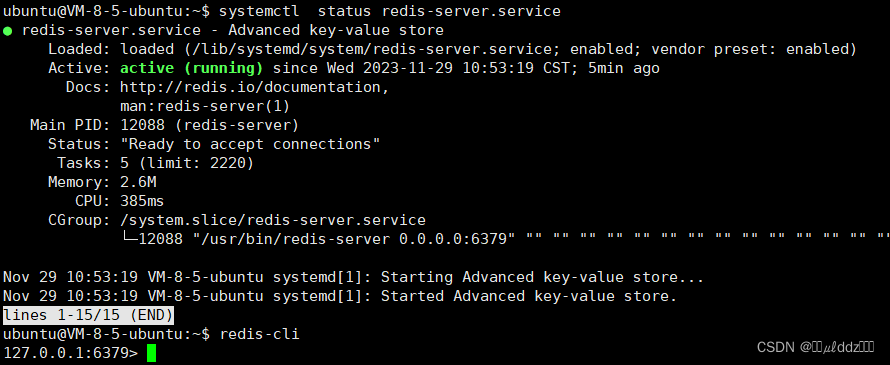目录
前言
限流是大型系统必备的保护措施,常用的限流算法主要有固定时间窗口,滑动时间窗口,漏桶,令牌桶等。本文将会写道的方案是使用 滑动时间窗口 算法,通过拒绝请求的方式来达到限流的目的。 本文的实现方式是 redis , lua 脚本 以及 Nestjs Guard 来实现 限流的效果。
概念浅析
这里简单说一下 固定时间窗口 和滑动时间窗口的概念
固定时间窗口 它可以解决 每 时间单位(可以是秒或者分钟等等),允许访问的次数。但是无法控制频率。举例1分钟允许访问100 次,可能前10 秒访问了90次,后面只有10次机会了。 还有一个问题就是在两个时间单位的临界值上可能会超出阈值,继续用前面的例子,第59秒访问了60次,第二个时间单位前10秒访问了50 次,在横跨两个时间单位的20秒中,超出了阈值 (110>100)
滑动时间窗口 可以改善固定窗口的所带来超出阈值的问题。它将每个单位之间分割成若干小周期,当前时间单位不再是固定的,而是根据当前请求时间往后移动,即所谓滑动窗口。每个周期分的越小,限流控制的越精细。
具体实现
使用的主要包的版本 nestjs 8.0.0 ioredis 5.3.2
我们主要实现以下几个东西
- 一个 guard 文件 用于实现限流的业务逻辑
- 一个 decorator文件 , 装饰器,用于设置当前接口限流的频率,允许访问次数等字段
- 一个 redis 类 和一个lua 脚本
redis 相关
主要就是通过lua 脚本进行计数,达到限流的目的。这里做了一个优化,对执行lua 取了hash 值,在redis 运行一次后 ,可以使用evalsha 直接运行脚本,避免二次载入脚本。
import { Injectable } from '@nestjs/common';
import * as Redis from 'ioredis';
import { ConfigService } from '@app/common';
import { createHash } from 'crypto'
import { v4 as uuidv4 } from 'uuid';
const rateLimitScript = ""// 后面单独列出
@Injectable()
export class RedisService {
private readonly redisClient: Redis.Redis;
private luaScript: any;
constructor(
private readonly configService: ConfigService,
) {
const self = this;
const connConfig = this.configService.get("redisService")
this.redisClient = new Redis.Redis(connConfig)
this.luaScript = {
rateLimit: {
script: rateLimitScript,
hash: self.hashStr(rateLimitScript)
},
}
}
private hashStr(value: string) {
return createHash("sha1").update(value).digest('hex')
}
async rateLimit(opts: any): Promise<boolean> {
const { key, limit, windowSize } = opts;
const uuid = uuidv4()
let result;
const { script, hash } = this.luaScript.rateLimit
try {
const shaResult = await this.redisClient.evalsha(hash, 1, key, limit, windowSize, uuid)
result = shaResult
} catch (error) {
const shaResult = await this.redisClient.eval(script, 1, key, limit, windowSize, uuid)
result = shaResult
}
return result == 1
}
}
接下来展示lua 脚本
--传入四个参数 分别是key,限制次数,时间范围,唯一值
local key = KEYS[1]
local limit = tonumber(ARGV[1])
local windowSize = tonumber(ARGV[2]) --单位毫秒
local uuid = ARGV[3] -- 唯一值是为了防止zset 重复
-- 使用redis 来获取时间,防止多进程生成相似的边界导致超频。时间单位是微秒
local date = redis.call("time")
local now = tonumber(date[1]) * 1000000 + tonumber(date[2])
local startTime = now - windowSize * 1000
local endTime = now + 1000000
-- 计算过期时间 时间单位是秒
local expireSec = tonumber(math.ceil(windowSize / 1000)) + 1
-- 统计当前zset数组里的数据,超出范围则返回0,
-- 否则做3件事,然后返回1
-- 1、向数组里增加新值
-- 2、删除数组中开始时间之前的数据,防止数组过大
-- 3、给数组续过期时间
local count = tonumber(redis.call('zcount', key, startTime, endTime))
if count + 1 > limit then
return 0
else
redis.call('zadd', key, now, uuid)
redis.call('zremrangebyscore', key, 0, startTime - 100000)
redis.call('expire', key, expireSec)
return 1
end
装饰器相关
这个很简单就是,设置一下redis 键值的前缀,允许访问的次数和 单位之间的长度。在这里设置了之后可以在 guard 里通过反射拿到这些值
import { SetMetadata } from '@nestjs/common';
export interface rateLimitOptions {
keyPrefix: string,
limit: number,
windowSize: number
}
export const RateLimit = (options: rateLimitOptions): MethodDecorator => SetMetadata('rateLimit', options)
guard 相关
guard 就是把之前的部分整合了一下,如果当前接口没有设置限流参数则启用默认参数,keyprefix 取当前接口的路径。
import { Injectable, ExecutionContext, CanActivate } from "@nestjs/common";
import { Reflector } from '@nestjs/core';
import { RedisService, rateLimitOptions } from "@app/common";
import { BusinessException } from "@app/common";
@Injectable()
export class RateLimitGuard implements CanActivate {
constructor(
private reflector: Reflector,
private redisService: RedisService
) { }
private getIpFromRequest(request: { ip: string }): string {
return request.ip?.match(/\b\d{1,3}\.\d{1,3}\.\d{1,3}\.\d{1,3}\b/)?.[0]
}
async canActivate(context: ExecutionContext) {
// 通过反射拿到前面设置的值
const rateLimitConfig = this.reflector.get<rateLimitOptions>("rateLimit", context.getHandler());
if (!rateLimitConfig) {
// 当前接口如果没设置参数则定义默认参数
const cMethod = this.reflector.get("method", context.getHandler());// 是GET,POST 等http method
const cPath = this.reflector.get("path", context.getHandler());// 接口的具体路径
rateLimitConfig = {
keyPrefix: cMethod + ":" + cPath,
limit: 1,
windowSize: 5000
}
}
const { keyPrefix, limit, windowSize } = rateLimitConfig
const request = context.switchToHttp().getRequest();
const ip = this.getIpFromRequest(request)
const key = keyPrefix + ":" + ip
const isPass = await this.redisService.rateLimit({
key,
limit,
windowSize
})
if (!isPass) {
// 返回自定义的错误
throw new BusinessException("RATE_LIMIT_EXCEEDED_LIMIT")
}
return true
}
}
使用方法
引入guand 和RateLimit 装饰器,可以给特定路由增加限流保护
@Controller('user')
export class UserController {
constructor(private readonly userService: UserService) { }
@Public()
@RateLimit({ keyPrefix: "login", limit: 3, windowSize: 1000 })
@UseGuards(RateLimitGuard)
@Post('register')
register(@Body() createUserDto: CreateUserDto) {
return this.userService.register(createUserDto);
}
}
或者基于模块的也可以,这样路由里的就可以省略了,如果某些接口没设置RateLimit 参数,guard 内部就会使用默认统一参数。
@Module({
providers: [
{
provide: APP_GUARD,
useClass: RateLimitGuard
}
],
})
使用ab 测试一下结果,为了便于测试设置为每5秒可以请求3次。用 ab进行两次测试,结果如下
2023-11-25 17:50:39 - error - HttpExceptionFilter - d1385d48-183c-4fbf-b751-4d0b6786f5ba : {"validatorCode":10005,"validatorMessage":"用户已存在"} - {}
2023-11-25 17:50:39 - error - HttpExceptionFilter - 65f0e427-92e4-4854-a6cc-116c70daac61 : {"validatorCode":10005,"validatorMessage":"用户已存在"} - {}
2023-11-25 17:50:39 - error - HttpExceptionFilter - b24b8f7e-f961-45d1-a909-36219fc5d112 : {"validatorCode":10005,"validatorMessage":"用户已存在"} - {}
2023-11-25 17:50:39 - error - HttpExceptionFilter - 9c65d452-8eeb-4c40-a76e-b5bf01524ebb : {"validatorCode":30000,"validatorMessage":"请求频率过快"} - {}
2023-11-25 17:50:39 - error - HttpExceptionFilter - 1065a900-bb55-4514-9b55-08cc57509e37 : {"validatorCode":30000,"validatorMessage":"请求频率过快"} - {}
2023-11-25 17:50:45 - error - HttpExceptionFilter - a8176f1c-2788-4e2a-8267-4e2ffadb6238 : {"validatorCode":10005,"validatorMessage":"用户已存在"} - {}
2023-11-25 17:50:45 - error - HttpExceptionFilter - db911d44-ee8b-4da2-a87b-fa0bcb433c45 : {"validatorCode":10005,"validatorMessage":"用户已存在"} - {}
2023-11-25 17:50:45 - error - HttpExceptionFilter - 3c59e335-441b-4907-80e4-0d807e5bfb01 : {"validatorCode":10005,"validatorMessage":"用户已存在"} - {}
2023-11-25 17:50:45 - error - HttpExceptionFilter - 6f48108b-bc8e-4fb6-8231-fa5a9cd22b5f : {"validatorCode":30000,"validatorMessage":"请求频率过快"} - {}
2023-11-25 17:50:45 - error - HttpExceptionFilter - 7c77c1df-bfe6-4f72-b75a-0d9a1211fe64 : {"validatorCode":30000,"validatorMessage":"请求频率过快"} - {}
达到要求,收工。
以上就是NestJS+Redis实现手写一个限流器的详细内容,更多关于NestJS Redis限流器的资料请关注脚本之家其它相关文章!
本文由 华域联盟 原创撰写:华域联盟 » NestJS+Redis实现手写一个限流器
转载请保留出处和原文链接:https://www.cnhackhy.com/157482.htm





